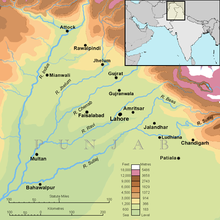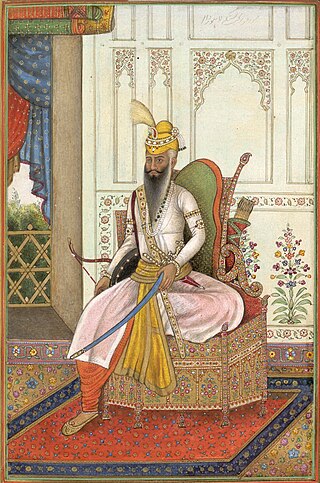
Ranjit Singh, popularly known as Sher-e-Punjab or "Lion of Punjab", was the first Maharaja of the Sikh Empire, which ruled the northwest Indian subcontinent in the early half of the 19th century. He survived smallpox in infancy but lost sight in his left eye. He fought his first battle alongside his father at age 10. After his father died around Ranjit's early teenage years, Ranjit subsequently fought several wars to expel the Afghans throughout his teenage years. At the age of 21, he was proclaimed the "Maharaja of Punjab". His empire grew in the Punjab region under his leadership through 1839.

The first Anglo-Sikh war was fought between the Sikh Empire and the British East India Company in 1845 and 1846 around the Ferozepur district of Punjab. It resulted in defeat and partial subjugation of the Sikh empire and cession of Jammu & Kashmir as a separate princely state under British suzerainty.

The Fauj-i-Khas was a brigade of the Fauj-i-Ain section of the Sikh Khalsa Army of Punjab. It consisted of very experienced elites and had separate flag and emblem. It was strictly disciplined on French pattern. All the equipment and weapons were of the best type. It grew to be the best organised section of the regular army (Fauj-i-Ain)

Sher Singh was the fourth Maharaja of the Sikh Empire. Elder of the twins of Maharaja Ranjit Singh, founder of the Sikh Empire and Maharani Mehtab Kaur. His reign began on 18 January 1840 following his assault on Lahore which ended the brief regency of Maharani Chand Kaur. He was assassinated on 15 September 1843 by Ajit Singh Sandhawalia.

The Sikh Empire was a regional power based in the Punjab region of the Indian subcontinent. It existed from 1799, when Maharaja Ranjit Singh captured Lahore, to 1849, when it was defeated and conquered by the British East India Company in the Second Anglo-Sikh War. It was forged on the foundations of the Khalsa from a collection of autonomous misls. At its peak in the 19th century, the empire extended from Gilgit and Tibet in the north to the deserts of Sindh in the south and from the Khyber Pass in the west to the Sutlej in the east as far as Oudh. It was divided into four provinces: Lahore, which became the Sikh capital; Multan; Peshawar; and Kashmir from 1799 to 1849. Religiously diverse, with an estimated population of 4.5 million in 1831, it was the last major region of the Indian subcontinent to be annexed by the British Empire.

Maharani Jind Kaur was regent of the Sikh Empire from 1843 until 29 March 1847. After the Sikh Empire was dissolved on 29 March 1847 the Sikhs claimed her as the Maharani and successor of Maharaja Duleep Singh. However, on the same day the British took full control and refused to accept the claims.

Hari Singh Nalwa was Commander-in-chief of the Sikh Khalsa Fauj, the army of the Sikh Empire. He is known for his role in the conquests of Kasur, Sialkot, Attock, Multan, Kashmir, Peshawar and Jamrud. Hari Singh Nalwa was responsible for expanding the frontier of Sikh Empire to beyond the Indus River right up to the mouth of the Khyber Pass. At the time of his death, the western boundary of the empire was Jamrud.

Maharaja Gulab Singh Jamwal (1792–1857) was the founder of Dogra dynasty and the first Maharaja of the princely state of Jammu and Kashmir, which was a part of Panjab and Sikh Empire became the largest princely state under the British Raj, which was created after the defeat of the Sikh Empire in the First Anglo-Sikh War. During the war, Gulab Singh would later side with the British and end up becoming the Prime Minister of Sikh Empire. The Treaty of Amritsar (1846) formalised the transfer of all the lands in Kashmir that were ceded to them by the Sikhs by the Treaty of Lahore.
Sandhawalia is a Jat clan of present-day India and Pakistan.

The Sikh Khalsa Army, also known as Khalsaji or simply Sikh Army, was the military force of the Sikh Empire. With its roots in the Khalsa founded by Guru Gobind Singh, the army was later modernised on Franco-British principles by Maharaja Ranjit Singh. It was divided in three wings: the Fauj-i-Khas (elites), Fauj-i-Ain and Fauj-i-Be Qawaid (irregulars). Due to the lifelong efforts of the Maharaja and his European officers, it gradually became a prominent fighting force of Asia. Ranjit Singh changed and improved the training and organisation of his army. He reorganized responsibility and set performance standards in logistical efficiency in troop deployment, manoeuvre, and marksmanship. He reformed the staffing to emphasize steady fire over cavalry and guerrilla warfare, improved the equipment and methods of war. The military system of Ranjit Singh combined the best of both old and new ideas. He strengthened the infantry and the artillery. He paid the members of the standing army from treasury, instead of the Mughal method of paying an army with local feudal levies.
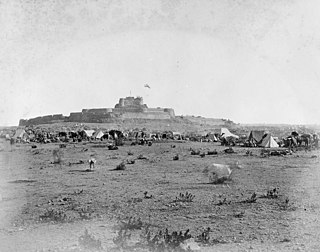
The Jamrud Fort is located beside Bab-e-Khyber at the entrance to the Khyber Pass from the Peshawar side in the tribal district of Khyber KPK, Pakistan. After death of Sardar General Hari Singh Nalwa, Khalsa Sarkar Wazir Jawahar Singh nominated Sardar General Gurmukh Singh Lamba as chief administrative and military commander to restore and consolidate the Khalsa army gains. General Sardar Gurmukh Singh Lamba was nominated as chief administrative and military commander to consolidate the gains of Khalsa Sarkar.
Raja Mahan Singh Mirpuri was a famous general in the Sikh Khalsa Army, and was the second-in-command to General Hari Singh Nalwa. He was conferred by Maharaja Ranjit Singh the title of Raja for his conquests of Haripur, Nowshera and Peshawar. The town of Mansehra derives its name from him.

Kanwar Sri Bikrama Singh Bahadur was a 19th-century Sikh leader.
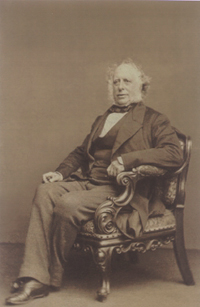
Sir Frederick Currie, 1st Baronet was a British diplomat, who had a distinguished career in the British East India Company and the Indian Civil Service. His posts included Foreign Secretary to the Government of India, Member of the Supreme Council of India, Resident at Lahore and Chairman of the East India Company.

The Battle of Nowshera was fought in Nowshera in March 1823 between the Yusufzai Afghans, supported by the Peshawar sardars, alongside Azim Khan Barakzai, the Afghan governor of Peshawar, where they would face the Sikh armies led by Maharaja Ranjit Singh. Azim Khan was a half-brother of Dost Mohammad Khan, future ruler of Kabul, and later Afghanistan. The battle was a victory for the Sikhs, successfully defeating Azim Khan's armies. This victory allowed them to begin to their occupation of the Peshawar Valley.
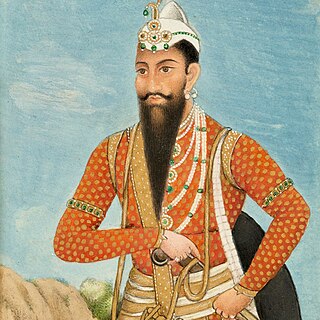
Kharak Singh was the second Maharaja of the Sikh Empire. He was the eldest son of Maharaja Ranjit Singh, founder of the Sikh Empire and his consort, Maharani Datar Kaur. He succeeded his father on 27 June 1839 and reigned until his dethronement and imprisonment on 8 October 1839. He was succeeded by his only son Nau Nihal Singh.

The Sikh Rule in Lahore initiated from the conquest and rule of the Sikh Misls and extended till the Sikh Empire of Ranjit Singh which ended in 1849. The Sikhs began gaining power following the decline of the Mughal Empire in Punjab and consisted of a collection of autonomous Punjabi Misls, which were governed by Misldars, mainly in the Punjab region.

Kunwar Pashaura Singh (1821 – 11 September 1845), also spelt Peshawara Singh, sometimes styled as Shahzada, was the younger son of Maharaja Ranjit Singh and Rani Daya Kaur.

Tej Singh was a Sikh commander in the Sikh Empire. He was appointed as Commander in chief of the Sikh Khalsa Army during the First Anglo-Sikh War.


